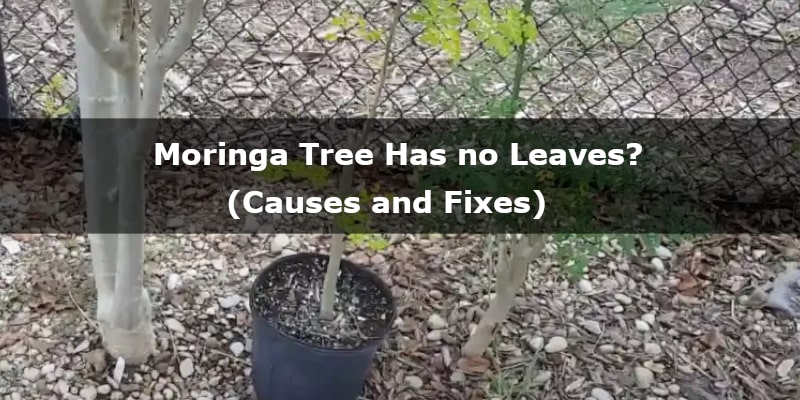So, your outdoor, or indoor Moringa Tree has no leaves?
Don’t worry, in this article, you will find out the cause of it, and how you can revive your tree.
Why Doesn’t Moringa Tree Have Leaves?
There are 7 main reasons why Moringa Tree has no leaves. However, the most common one is part of seasonal growth, when the tree is losing its leaves during colder months.
Moringa might experience no leaves because of environmental shock if you change its location. It’s also possible that you are watering the tree in the wrong way, or don’t provide enough sunlight.
If you want to get to know all the causes, symptoms, and fixes, keep reading this article.
Part of Seasonal Growth
One of the most common reasons why Moringa Tree is losing leaves is part of seasonal growth. Like many other trees, Moringa is deciduous, which means that when the temperatures are getting lower, the tree loses its leaves, and stops producing new ones.
Moringa Tree should start losing its first leaves in September, but it depends on the area. However, you should be patient, because the tree will grow new leaves in the spring.
No matter if you keep the tree indoors, or outdoors, it will go dormant in the winter and lose all of its leaves.
Environment Change
If you exclude the first reason, you should consider environmental shock. A Moringa Tree might leaf out, because of a sudden change in conditions. If you take the tree from outdoor to indoor, or from indoor to outdoor, the plant might experience shock due to changes in temperature, humidity, light levels, or watering habits.
Usually, the shock is temporary as the plant adjusts to new conditions. The tree should quickly revive and start producing new leaves. If you want to avoid environmental change in the future, you can gradually acclimate the tree.
For example, if you intend to take the Moringa Tree from the outdoor to the indoor, give the plant increasing long visits indoors. Start from short visits, and increase their duration over time. Do the same if you want to move the plant from indoors to outdoors.
Overwatering
So, your Moringa has no leaves not because of winter, or environment shock? Maybe it’s a problem with overwatering.
Moringa Tree hates it when it’s overwatered, as it’s not a heavy drinker. If you let the soil sit in the puddle for a longer period of time, the root can rot quickly, and the leaves might turn yellow, or brown, and might fall. As a result of root rot, the plant might ultimately be killed.
If you suspect that you might have overwatered your plant, you should cut off the healthy part of the root (if there is still any), and plant the tree again. If the whole root is rotten, there is no way you can save the tree. It’s easy to overwater a Moringa Tree, especially if it’s young.
The best way to water a Moringa Tree is to water it as soon as the top few inches of the soil dry out. When you feel like most part of the soil has dried up, give the plant a hearty drink of water until the water flows out of the drainage holes.
If your pot doesn’t have drainage holes, make sure to drill them. If the tree grows outdoors, the soil should be also well-drained.
Underwatering
Underwatering might also cause leaf drop, but it’s more common in young Moringa Trees, especially the ones growing in a pot, but in some cases growing in the ground.
If you don’t water the tree once the soil dries out, the foliage will wither off, the leaves will drop off, and the plant will slow down its growth. To prevent that, make sure that you water the plant regularly, and keep the soil moist most of the time.
Mature plants are more drought resistant and can go many days without water. Drought encourages the roots to grow deep into the soil in search of water. However, you should still remember about infrequent, but deep watering if you don’t want to experience leaf shedding and stunt growth.
Not Enough Light
Not enough light is a common sign of leaf drop, especially if the Moringa Tree is kept indoors. This tree requires at least 6 hours of direct sunlight per day. Otherwise, besides leaf drop, the tree will experience stunt growth and a worse overall appearance.
If you keep the tree at home, or you want to overwinter it indoors, make sure to pick the sunniest spot, close to the window where it can get as much sun as possible. However, the results are not guaranteed, because this tree doesn’t do well indoors, even if it gets enough light, so it still might lose its leaves.
Moringa Tree does way better outdoors. This tree loves the sun, and it will lose its trees either in the fall, when it goes dormant, or when other trees block the sunlight. If that’s the case for you, make sure to prune the plants that deprive the Moringa Tree of access to direct sunlight.
Pests or Disease
Pests and diseases that might cause no leaves of Moringa Tree include root rot and aphids.
I’ve already mentioned root rot, and you know that to avoid it. You shouldn’t overwater the plant, and provide good drainage.
However, pests such as aphids, spider mites, and hairy caterpillars might appear randomly, and they can kill your plant. To protect your plant, you should consider spraying the plant with Neem Oil (buy here on Amazon) every two weeks until the insects are eradicated. It’s also a good way to prevent these insects even if the tree is healthy.
Wrong Fertilization
When Moringa Tree is young, you should support its growth with fertilizer to prevent leaf drop. You can apply an organic fertilizer that slows down nutrient excertion, or some NPK fertilizer of 2:1:1, or 3:1:1. You can buy one here on Amazon.

